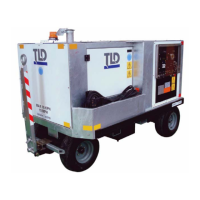Creation:03.09 — 2009 1-1-16
Description
F. Contactors
The GPU’s contactors are mounted on the inside bottom surface of the electrical box. The
contactor is wired to it’s own bridge rectifier. These components, together with interlock relays)
and Note that for 60 KVA GPU’s.
(1) Load Contactor and Bridge Rectifier
The bridge rectifier receives 400 Hz AC from phase C of the generator output and
converts it to a pulsating direct current for energization of the output load contactor
holding coil, K10. This DC coil holding circuit is controlled indirectly by controlling the 400
Hz A.C. to the rectifier. The hot line for the rectifier AC supply must pass through the
generator control module’s protective circuit, therefore any time a generator protective
device functions to trigger the relays, the rectifiers AC circuit is interrupted. No DC power
is then available for the load contactor holding coil, K10, hence, the load contactor opens.
When 400 Hz power is supplied to the aircraft, the aircraft returns a voltage signal to the
GPU through the E & F pins of the output cable and terminal block. This return signal is
used to energize either of the interlock relays (K11), which allow power to go to the
generator control module, then through either of the output contactor switches (S10),
through the bridge rectifiers (CR1), and finally to the output contactor coils (K10). If the
aircraft decides 400 Hz power is no longer required, it will cut the return signal through the
E and F pins causing the GPU’s contactor(s) top open.
The output load contactor contains three main contact sets. The three main contacts
conduct three-phase AC generator output. Three-phase, 400 Hz generator output cables
are connected from the generator to the line side of the load contactor by passing through
a set of current transformers. From the contactor, power is brought to the aircraft via
output terminal block(s) and 400 Hz output cables (in varous lengths) and plugs.
(2) Voltage Adjustment Rheostat
The voltage adjustment rheostat provides adjustment of the regulated generator output
voltage plus or minus 10% of the nominal.

